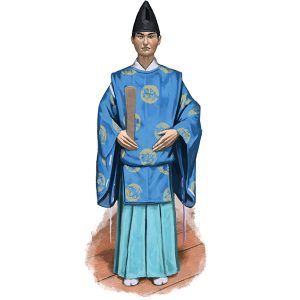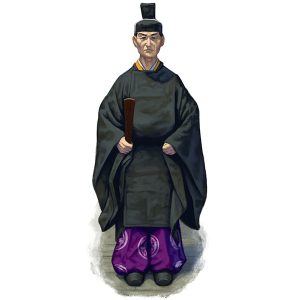Shinto priests wear distinctive vestments when performing ceremonies, based on the clothes worn by the nobility of the Heian period (ca 800 – 1200 CE). The vestments are different for male and female priests, and for priests of different ranks, and for matsuri of different levels of importance. This post just gives a couple of representative examples for male priests, as most Shinto priests are still male. (I plan another post on female priests in the near future.)
The base of the vestments, for both male and female priests, is a white kimono with hakama, which are usually coloured. There are two styles of vestments, Saifuku and Jōë, in which the hakama are white, but they are worn less often than the other forms at most jinja. Most of the time, priests who are on duty but not actually performing a matsuri wear just the kimono and hakama, putting on the remaining vestments when necessary. Off duty priests do not wear their vestments (although there are doubtless occasional exceptions).

Click image for larger version.
His black hat is called an “eboshi”. These hats are actually made of Japanese paper, washi, which is layered on to the shape and dyed black. So, yes, Shinto priests wear paper hats.
The wooden stick in his hand is called a “shaku”. In the distant past, courtiers wrote notes for the ceremonies on them, but they have been nothing more than a symbol of dignity for centuries. Up to the late nineteenth century only some priests were authorised to hold them, but all male priests have them now. There are specific rules for the etiquette to follow when a priest must put his shaku down or away in order to clap when paying reverence to the kami.

Click image for a larger version.
If the image to the right was of a priest of special rank, the highest, his hakama would be white, with the other colours the same. The patterns would still be on the hakama, but they would still be white, so they would be hard to see.
If he were of upper second rank, the hō would be red, and the patterns on the hakama would be fainter. A priest of second rank would still have a red hō, but his hakama would be purple without any patterns. A priest of the third or fourth rank would have a green hō, and hakama the same colour as in the picture to the left.
These differences in vestments mean that you can tell a lot about what is going on in a jinja at a single glance, and also spot people who are working at a jinja but who are not qualified priests (because they have hakama in different colours — white is ambiguous, however).
You mention that the shaku is no longer used for crib notes; do priests now write their notes on something else, or are they expected to have better memories these days, or are the ceremonies now shorter and simpler so notes are not necessary?
The ceremonies are consistent. However, male priests do, in formal ceremonies, hold the piece of paper with the norito written on against their shaku, before opening it out to read it, so a bit of the historical usage remains.
Pingback: Female Priestly Vestments – Mimusubi
Pingback: Shinto Vestments – Mimusubi